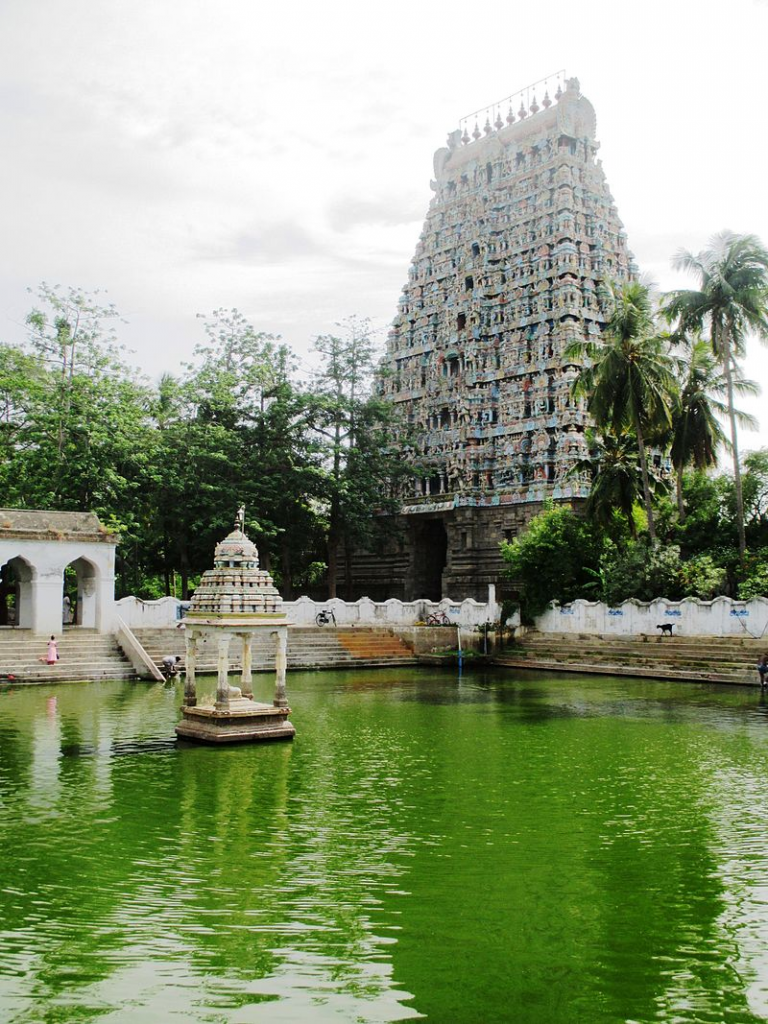Mayuranathaswamy Temple, Mayiladuthurai or Mayuranathar Temple is a Hindu temple in the town of Mayiladuthurai (formerly known as Mayavaram or Mayuram) in Tamil Nadu, India.

The temple is dedicated to Lord Mayuranathaswamy, a form of Shiva, and has given its name to the town itself. The main icon is a Lingam and the presiding deity is called Mayuranathar because the Hindu goddess Parvathi worshipped Shiva here in the form of a Mayura.

On the day of the new moon in the Tamil month of Aippasi (November–December), religious Hindus have a ceremonial bath in the temple tank as it is believed to purify them from sins.
An annual dance festival called the Mayura Natyanjali festival is celebrated within the precincts of the temple each year.
Location
The Mayuranathaswami temple is located in the southern part of Mayiladuthurai about a mile from the Kaveri River. The temple is on the Chidambaram–Thanjavur highway.
Significance
Thiruvayyaru, Mayiladuthurai, Thiruvidaimaruthur, Thiruvenkadu, Chayavanam and Srivanchiyam are considered equivalents of Kashi.
Like in Kasi, where the city is centered around Kashi Vishwanath Temple, the temples in these towns along the banks of river Cauvery, namely, Aiyarappar temple in Thiruvaiyaru, Mahalingeswarar temple in Thiruvidaimarudur, Mayuranathaswamy temple in Mayiladuthurai, Chayavaneswarar temple in Sayavanam, Swetharanyeswarar temple in Thiruvenkadu, Srivanchinadhaswamy Koil in Srivanchiyam are the centerpieces of the towns.
The temple is counted as one of the temples built on the banks of River Kaveri.
The temple is one of the canonical shrines of the 275 Paadal Petra Sthalams – Shiva temples glorified in the early medieval Tevaram poems by Tamil Saivite Nayanar Tirugnanasambandar.
Architecture
The presiding deity is a Swayambhu lingam or a self-manifested Lingam, the symbol of the Hindu god Shiva. Shiva’s consort is known by the names Abhayapradhambikai, Abhayambikai, Anjalanayaki and Anjalai.
There are three smaller shrines to the Hindu god Ganesha and another to Shiva as Nataraja or “Lord of Dance”. One of the sculptures in the temple represent Shiva embracing Goddess Parvathi.
According to Sthala Purana, the goddess Parvathi, the consort of Shiva, once offended him. Shiva was so annoyed he cursed Parvathi to be born as a lowly peahen.
Later, when Parvathi repented, Shiva reduced this sentence. Parvathi had to pray first at Mylapore and then at Mayiladuthurai, at the end of which she was ridden of her curse and became known as “Abhayambal”.
It is believed that Brahma, Lakshmi, sage Agastya, Manmatha, birds and animals worshipped Mayuranathar.
The temple complex is 719 feet (219 m) long and 520 feet (160 m) wide. The Gopura at the eastern entrance to the temple is nine storeys high and measures 194 feet.
The idol of Durga near the northern entrance of the temple is expertly sculpted and differs from those in other temples. On the temple walls, there is the sculpture of a devotee trying to sever his head as an offering to the God.
There is an expansive temple tank in the centre of the complex. People travel in large numbers to Mayiladuthurai to bathe in this tank on the day of the new moon in the Tamil month of Aippasi (November–December).
This bath purifies a person of sins because the waters of the river Ganges and other Indian rivers mingle with the waters of the Kaveri river in this tank on this particular day.
History
The temple was built by the Medieval Cholas. The oldest inscriptions on the temple walls date to the time of Kulothunga Chola I. Massive renovations were carried out during 1907–1927 by Devakottai AL. VR. P. Veerappa Chettiar and Pethaperumal Chettiar.
